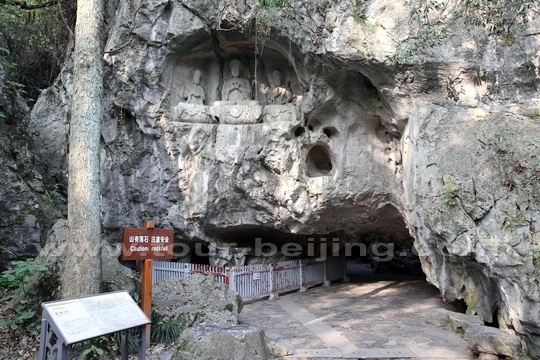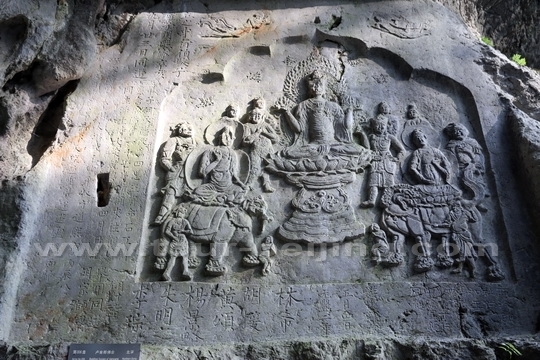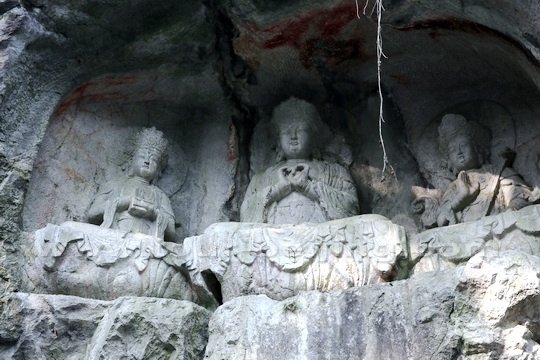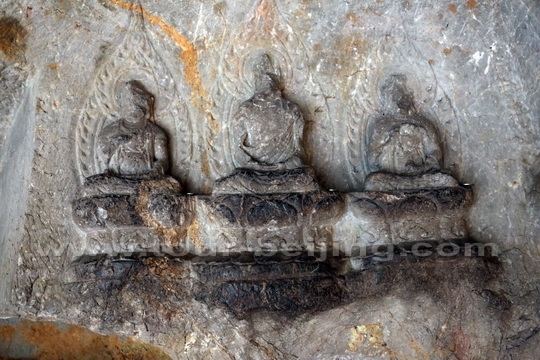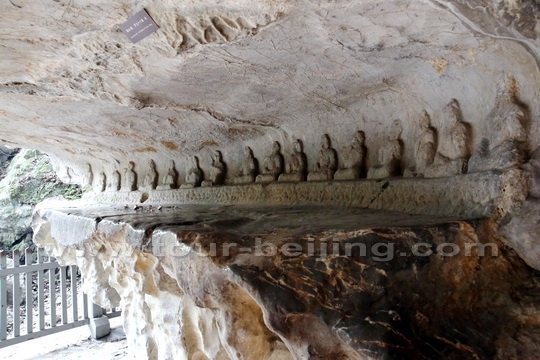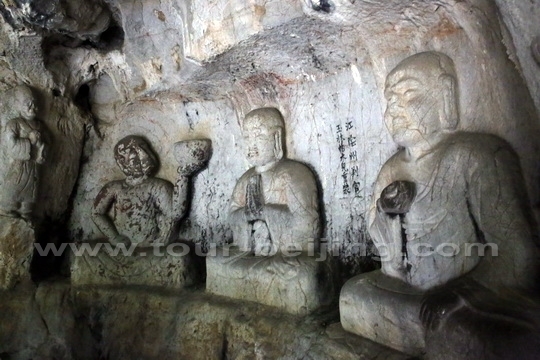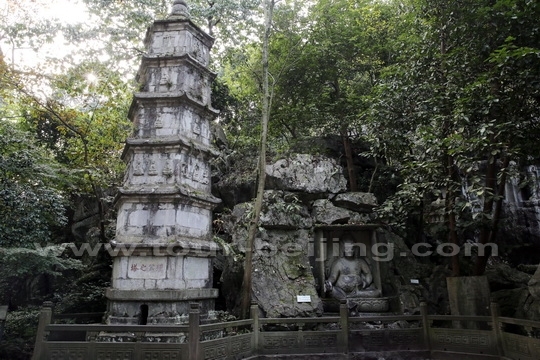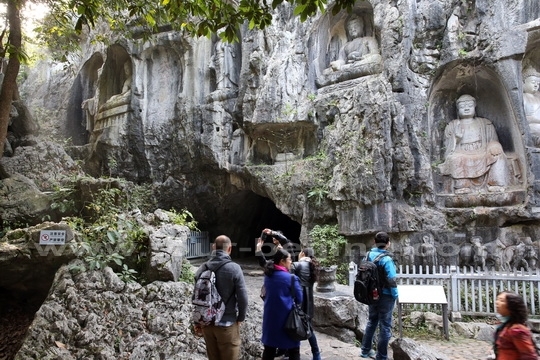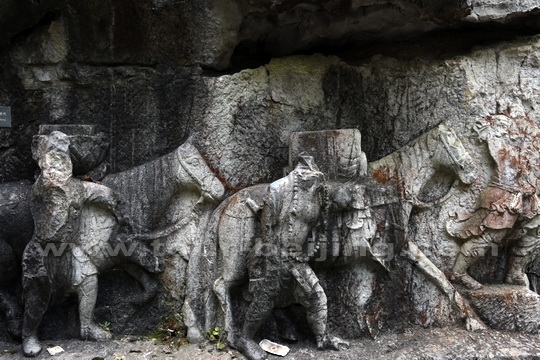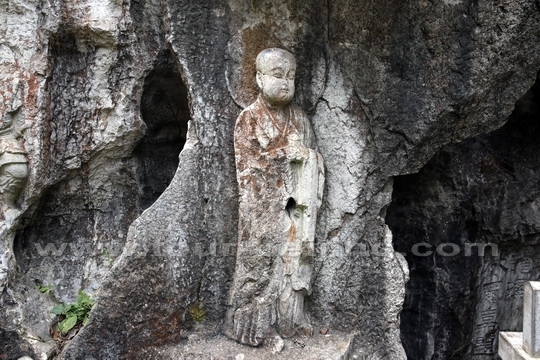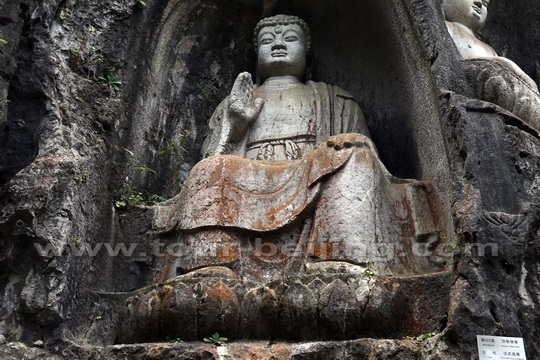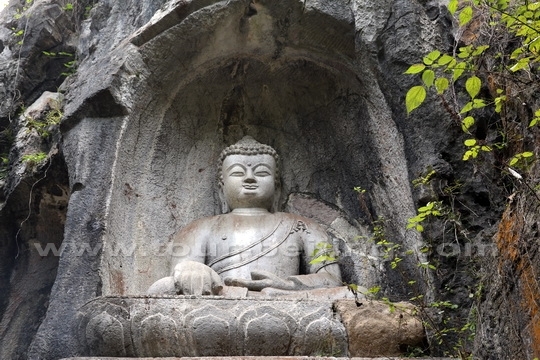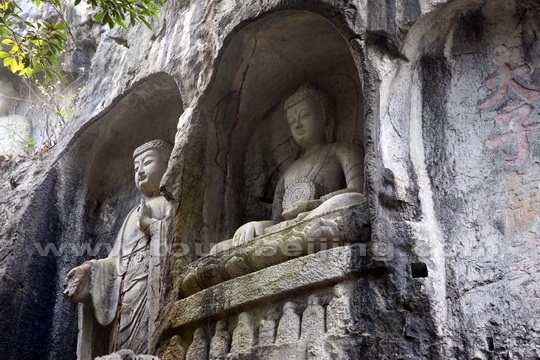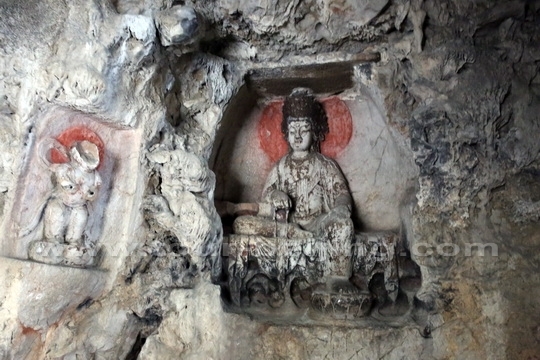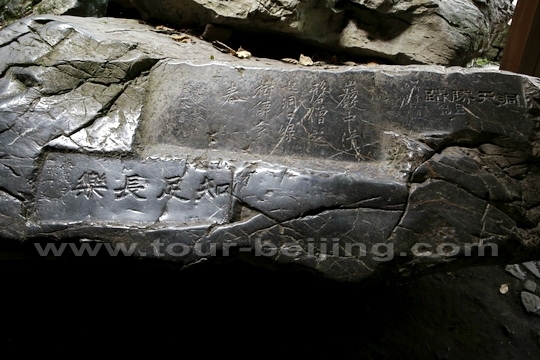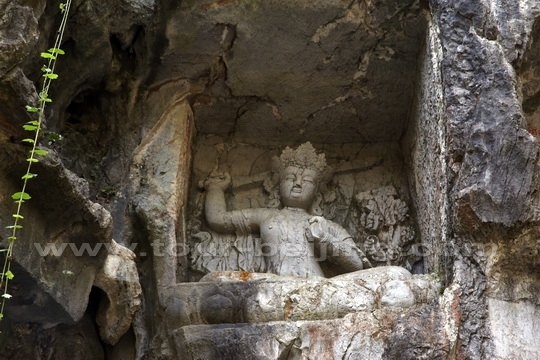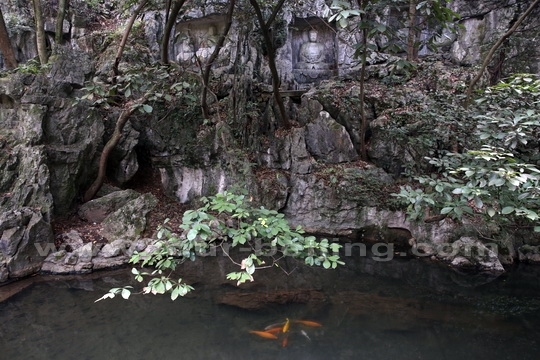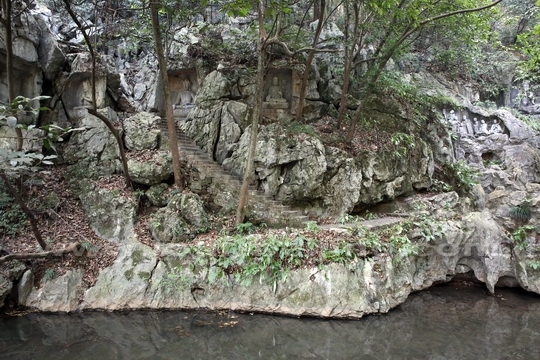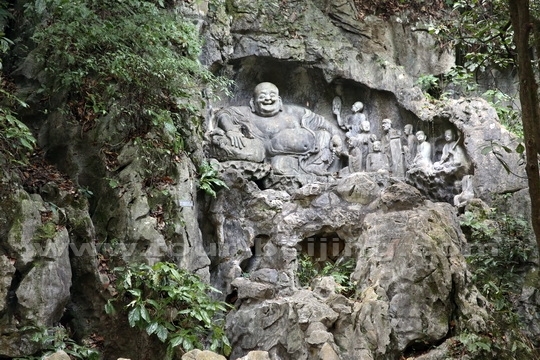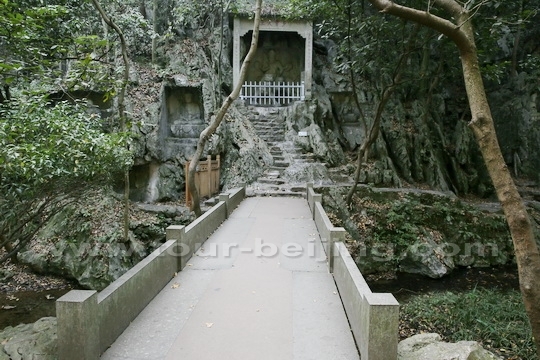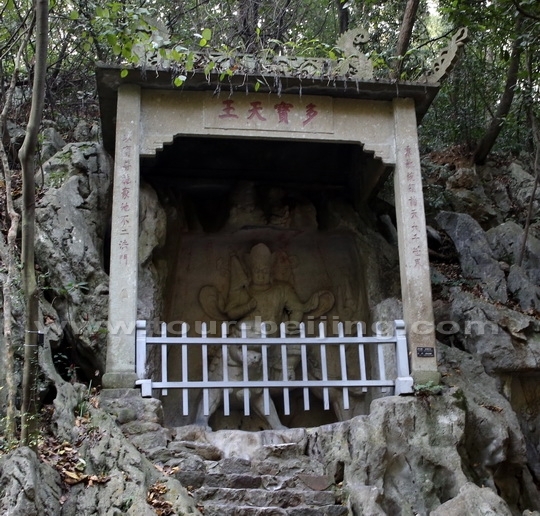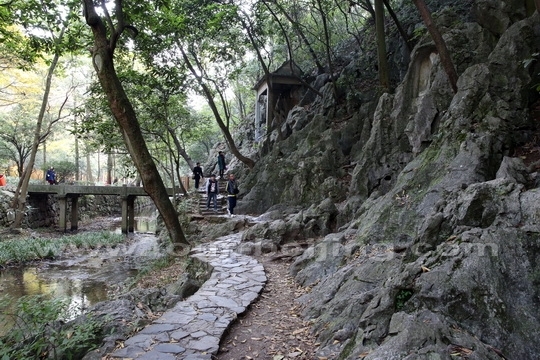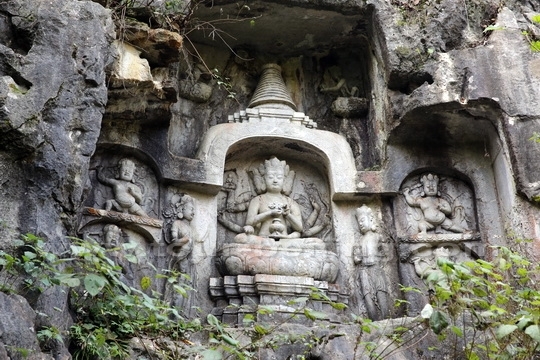Planning your Hangzhou tour? Unquestionably, walking, cycling around or boating on the West Lake (UNESCO World Cultural Heritage) will be your first choice. But Hangzhou is a city of no one-trick pony. Feilai Peak Buddhist Grottoes (Chinese:飞来峰石刻 Feilai Feng) is one of the impressive sites in Hangzhou, which is worth your exploration 2-3 hour together with a visit to Lingyin Temple.
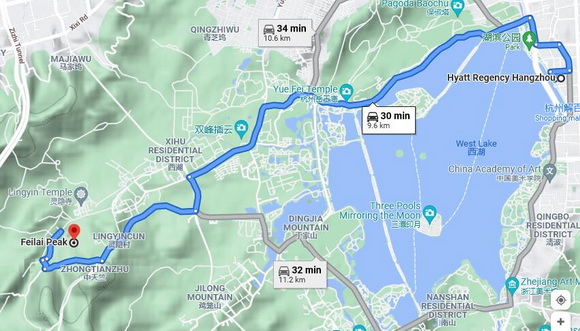
ABC of Feilai Peak ( Peak Flying from afar )
Feilai Peak, literally, “Peak flying from afar”, is located near Lingyin Temple, separated by a stream. The peak is of craggy limestone formation, quite different from the surrounding sandstone mountains, hence the name of the Feilai Peak (the Flying Peak). Its name is also related to a legend that the peak was thought to have flown from India, a manifestation of the omnipotence of Buddhism.
The charm of the legendary peak are the over 470 stone statues carved on its hillsides and riverbanks between the 10th and 14th centuries. 335 of the 470 Buddhist carvings are relatively well preserved. The grottoes in the Flying Peak have filled vacuum of Buddhist carvings done in the period ranging from Five Dynasties and Ten Kingdoms (907-960) to Yuan Dynasty (1271 – 1368).
Most of the grottoes were made during Song Dynasty ( over 200 statues) and Yuan Dynasty ( 116 statues). Only a small number of the stone statues were done in Five Dynasties and Ten Kingdoms (907-960) period. The earliest rock carving was made in 951. The Flying Peak Grottoes were representative of the Buddhist rock carvings after Dunhuang Mogao Grottoes, Datong Yungang Grottoes, Tianshui Maijishan Grottoes and Luoyang Longmen Grottoes.
How to get there & Entrance fees
Feilai Peak, adjacent to Lingyin Temple, can be effortlessly reached by taking the public buses – Bus lines: Y1, Y2, K 7, Y2, J17, 837, K7、K807, J18, K837
The Flying Peak Entrance Fee: RMB 45
Lingyin Temple Entrance Fee: RMB 35
Virtual Tour of Feilai Peak Grottoes
Now follow me to have a glimpse of the impressive rock carving statues dotted on the hillsides and Lengquan Brook along the peak. Let’s go visit each major caves where grottoes and niches are housed in the peak including Qinglin Cave, Yuru Cave, Longhong Cave, and more scattered caves and niches.
You’ d better off visiting the niches and caves on the hillsides of the Flying Peak by following the paths along the far east side of the stream, and then move on to Lingyin Temple.
Qinglin Cave
Starting from the far east, you first visit Qinglin Cave, which is also known as Tiger Cave since its south entrance looks like a tiger’s mouth.The cave has an area of 373 square meters with 23 niches and 178 statues. Most of the statues were carved in the style of Wuyue Kingdom (907-978) during the Five Dynasties period (907-960) and Northern Song Dynasty (960-1127).
The South Entrance to Qinglin Cave
The Rock Carving of Locana Buddhist Ceremony at the entrance
The Buddhist Statues of the Three Saints of Huayan carved at the entrance
The Three Saints of the West carved in 951 inside the cave, the earliest Buddhist carving in Feilai Peak Grottoes.
The Three Saints of the West carved in 951 inside the cave
The carved 18 arhats above a huge rock bed also known as Master Ji Gong’s rock bed and his fingerprint.
Yuru Cave
Move on to Yuru cave. The cave is also known as Cave of Bats or Cave Arhats. “Yuru” literally means “Jade Milk” named after the milk-like drippings of limestone from the ceiling.
The cave has an area of 270 square meters. There is a group of arhats, relief carvings and God of thunder. On the cliff at the eastern entrance there are 6 niches and 39 statues.
Ligong Pagoda
Ligong Pagoda is the only remaining Ming-era pagoda in Hangzhou, made of stones with six stories and six sides.
Longhong Cave
Longhong Cave is also called the Tong Tian Dong (the Cave leading to the sky) or Guanyin Cave. The cave has an area of 253 square meters, housing 43 statues and 27 niches. With a small number statues carved in the Northern Song Dynasty (960 – 1127), most of the statues were carved in Yuan Dynasty (1260 – 1368).
On the western entrance at Longhong Cave there is a group of 6 statues depicting the pilgrimages made by eminent monks to obtain Buddhist scriptures.
The three people in the middle of the group featured the story of Zhu Shixing of Yinhchuan County that belonged to the Statue of Wei (220-265) during the period of Three Kingdoms (220-280). He was the first Chinese monk who traveled to western Asia for Buddhist scriptures. The relief scripture features three striding human figures leading two horses. It is a pity that the head parts have been damaged.
The relief scripture features three striding human figures leading two horses
The 1.3 meter high statue is the eminent monk known as Xuanzhuang in Tang Dynasty. He traveled India and later brought a lot of scriptures from India.
The statue of Maitreya was carved in Chinese style in Yuan Dynasty ( 1172 – 1368) housed in Niche No.22
The statue was Sakymuni, a sanskrit-style carved in Yuan Dynasty ( 1172 – 1368)
The two statues in sitting and standing positions are above the entrance to Longhong Cave.
The Guanyin Statue inside Longhong Cave. Guanyin, the Bodhisatta of infinite compassion of Mercy.
The four Carved Characters on the stone inside Longhong cave says ” Being content is being almost happy”.
The Statue of Manjusri carved in Yuan Dynasty ( 1271 – 1368 ) in the style of Sanskrit.
Lengquan Brook
It is also known as North Stream and Stone Gate Stream. The brook winds down from Feilai Peak. On the cliffs along the brook, there are 37 niches and 72 statues carved in Yuan Dynasty (1260 – 1368).
On the cliffs along the brook, there are 37 niches and 72 statues carved in Yuan Dynasty (1260 – 1368).
The largest niche in Feilai Peak – the Laughing Buddha with 18 arhats – Budai Maitreya, carved on the cliff above the stream.
A stone bridge over the stream leading to the highest statue in Feilai Peak – Umbrella Heaven King, carved in Yuan Dynasty.
A close-up view of the 2-meter high Umbrella Heaven King housed in 3.1-meter high niche in the style of Sanskrit.
Walk along the stone path on the river bank west of the Umbrella Heavenly King niche, you will will see more niches and statues.
The Buddha of Infinite Life, carved in Yuan Dynasty in the style of Sanskrit.
The statues of Ushnishavijaya. Ushnishavijaya is one of the three main Buddhist deities of longevity, along with the White Tara and Amitayus. Ushnishavijaya combines aspects of three goddesses (hence her three heads), each associated with a sadhana (wish). Ushnishavijaya has a white colored body, three faces and eight arms.
The statue of Mahāsthāmaprāpta carved in Yuan Dynasty in the Chinese style.
After visiting Feilai Peak Grottoes, you may cross the brook and visit Lingyin Temple.
Tip: Hassle-free Hangzhou Guided Tours
If you don’t want to go the do-it-yourself route and prefer the hassle-free escorted tours, here are some options for Hangzhou Guided Tours:
Hangzhou Tour
Hangzhou 4-Day Tour Package
Hangzhou 3-Day Tour Package
Hangzhou Private Tour
Hangzhou Theme Tour
Hangzhou Side Trips
Hangzhou Car Rental with Driver
Further Readings
Top 10 Attractions in Hangzhou
Top 10 Photography Spots in Hangzhou
Night View of West Lake in Hangzhou
The Best hiking trail in Hangzhou
The best time to visit Hangzhou
Hangzhou East Railway Station
Hangzhou Airport Arrival Hall
How to Visit Feilai Peak Grottoes in Hangzhou
Where to stay in Hangzhou
Hangzhou Bicycle Hire
Wushan Night Market in Hangzhou
Pedestrian Streets in Hangzhou
Hangzhou’s Best Bars & Nightclubs
Best Way to Visit Hangzhou from Shanghai
How to Visit Grand Canal Hangzhou
How to Visit Xiling Seal Engravers’ Society
How to Visit Liuhe Pagoda
Hangzhou Tea Plantation
How to Visit Leifeng Pagoda
How to visit Hupao Spring (Tiger Spring) Hangzhou
How to Visit Yellow Dragon Cave in Hangzhou
The Best Place to View Sunrise over West Lake Hangzhou
Any question, just drop a line.






